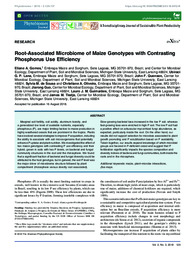Root-associated microbiome of maize genotypes with contrasting phosphorus use efficiency.
Root-associated microbiome of maize genotypes with contrasting phosphorus use efficiency.
Autoria: GOMES, E. A.; LANA, U. G. de P.; QUENSEN, J. F.; SOUSA, S. M. de; OLIVEIRA-PAIVA, C. A.; GUO, J.; GUIMARAES, L. J. M.; TIEDJE, J. M.
Resumo: Marginal soil fertility, soil acidity, aluminum toxicity, and a generalized low level of available nutrients, especially phosphorus (P), are major limiting factors to maize production in highly weathered oxisols that are prominent in the tropics. Plants have evolved several strategies to improve P acquisition, including the ability to associate with soil microorganisms that potentially enhance P uptake and plant nutrition. We investigated the effect of two maize genotypes with contrasting P use efficiency and their hybrid, grown in soils with two P levels, on bacterial and fungal community structures in the root and the rhizosphere. We found that a significant fraction of bacterial and fungal diversity could be attributed to the host genotype, but in general, the soil P level was the major driver of microbiome structure followed by plant compartment (rhizosphere versus directly root associated). Slow-growing bacterial taxa increased in the low P soil, whereas fast-growing taxa were enriched in high P soil. The low P soil had a positive effect on arbuscular mycorrhizal fungi abundance, as expected, particularly inside the root. On the other hand, our results did not support selection for microbes associated to plant growth promoting and P solubilization based on P availability. Taken together, our results expand knowledge of which microbial groups are favored in P-deficient oxisol and suggest that P fertilization significantly impacts the species composition and diversity indices of bacteria and fungi communities, both inside the roots and in the rhizosphere.
Ano de publicação: 2018
Tipo de publicação: Artigo de periódico
Unidade: Embrapa Milho e Sorgo
Palavras-chave: Fósforo, Interação planta-micróbio, Raiz, Zea Mays
Observações
1 - Por padrão são exibidas publicações dos últimos 20 anos. Para encontrar publicações mais antigas, configure o filtro ano de publicação, colocando o ano a partir do qual você deseja encontrar publicações. O filtro está na coluna da esquerda na busca acima.
2 - Para ler algumas publicações da Embrapa (apenas as que estão em formato ePub), é necessário ter, no celular ou computador, um desses softwares gratuitos. Sistemas Android: Google Play Livros; IOS: iBooks; Windows e Linux: software Calibre.
Acesse outras publicações
Acesse a Base de Dados da Pesquisa Agropecuária (BDPA) para consultar o acervo completo das bibliotecas da Embrapa.

